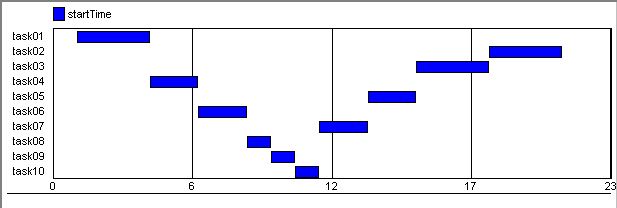- Function cp::SequentialSchedule(jobBinding, jobBegin, jobDuration, jobEnd)
cp::SequentialSchedule
The function cp::SequentialSchedule(j,s_j,d_j,e_j) models a resource
that can handle only one job at a time. A job \(j\) is scheduled
from start time \(s_j\) until, but not including, end time
\(e_j\) and over a number of periods \(d_j\). This function
returns 1 if the jobs are scheduled such that no two jobs overlap.
Mathematical Formulation
cp::SequentialSchedule(j,s_j,d_j,e_j) is equivalent to
Function Prototype
cp::SequentialSchedule(
jobBinding, ! (input) an index binding
jobBegin, ! (input) an expression
jobDuration, ! (input) an expression
jobEnd ! (input) an expression
)
Arguments
- jobBinding
An index binding that specifies and possibly limits the scope of indices. This argument follows the syntax of the index binding argument of iterative operators.
- jobBegin
An expression that involves variables. The result is a vector with an element for each possible value of the indices in
jobBinding.- jobDuration
An expression that may involve variables. The result of this expression is an integer non-negative value. The result is a vector with an element for each possible value of the indices in
jobBinding.- jobEnd
An expression that involves variables. This expression has the same data type as
jobBegin. The result is a vector with an element for each possible value of the indices injobBinding.
Return Value
This function returns 1 if the jobs can be scheduled such that no two jobs overlap. If the index binding argument
jobis empty, this function will return 1. Otherwise it returns 0.
Note
The arguments to this function involve discrete AIMMS variables and AIMMS parameters, not AIMMS activities.
This and similar constraints are also known in the Constraint Programming literature as
unaryordisjunctiveconstraints.
Example
The following example models the intuitive idea that with an increase in the size of a task also the time window in which that task is to be executed increases.
Parameter nrTasks {
Definition : 10;
}
Parameter smallestWidth {
Definition : 4;
}
Set tasks {
Index : t;
Definition : elementrange( 1, nrTasks, 1, 'task');
}
Parameter release {
IndexDomain : (t);
Definition : Ord(t);
}
Parameter deadline {
IndexDomain : (t);
Definition : 2*nrTasks-Ord(t)+smallestWidth;
}
Parameter processingTime {
IndexDomain : (t);
Definition : ceil(0.125*(deadline(t) - release(t)));
}
Variable startTime {
IndexDomain : (t);
Range : {
{release(t) .. deadline(t)}
}
}
Variable endTime {
IndexDomain : (t);
Range : {
{release(t) .. deadline(t)}
}
}
Constraint UnaryResource {
Definition : {
cp::SequentialSchedule(t, startTime(t),
processingTime(t), endTime(t))
}
}
This leads to the following results (extracted from the listing file):
name lower level upper
startTime('task01') 1 1 23
startTime('task02') 2 18 22
startTime('task03') 3 15 21
startTime('task04') 4 4 20
startTime('task05') 5 13 19
startTime('task06') 6 6 18
startTime('task07') 7 11 17
startTime('task08') 8 8 16
startTime('task09') 9 9 15
startTime('task10') 10 10 14
endTime('task01') 1 4 23
endTime('task02') 2 21 22
endTime('task03') 3 18 21
endTime('task04') 4 6 20
endTime('task05') 5 15 19
endTime('task06') 6 8 18
endTime('task07') 7 13 17
endTime('task08') 8 9 16
endTime('task09') 9 10 15
endTime('task10') 10 11 14
The following Gantt chart illustrates that the solution satisfies the restricition imposed by cp::SequentialSchedule.

Fig. 2 Gantt chart for solution of cp::SequentialSchedule.
See also
The examples at the function
cp::AllDifferentillustrate how the index binding and vector arguments are used.Constraint Programming on Constraint Programming in the Language Reference.
The Global Constraint Catalog, which references this function as
disjunctive.